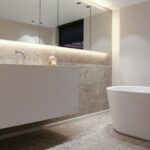Choosing the right finish for your floor tiles can have a big impact on the overall look and feel of your space. Matte and glossy are two popular options, each with their own unique characteristics.
In this article, we will explore the differences between matt tiles and gloss tiles, helping you make an informed decision.
Key Points
- Matte tiles have a non-reflective surface that offers a subtle and natural look. They’re ideal for creating a calm and serene atmosphere in your space. With their understated elegance, matte tiles can add a touch of tranquillity to your home.
- Glossy tiles have a shiny and reflective surface that exudes elegance and sophistication. They’re perfect for spaces where you want to create a sense of luxury and glamour. The glossy finish can enhance the overall aesthetic appeal of the room, making it feel more vibrant and polished.
- Different buildings or spaces have specific requirements for tile finishes. Matte tiles are commonly found in residential areas, where a cozy and relaxed atmosphere is desired. Glossy tiles are commonly used in commercial spaces such as hotels, restaurants, and offices.
- Matte tiles are well-suited for spaces that prioritise a soothing and natural feel, while glossy tiles are better suited for spaces that aim to create a more lavish and striking atmosphere.

What Are Matte Tiles?
Matte tiles are a popular choice for homeowners who want a sleek and understated look for their space.
The matte finish is achieved by using a natural clay composition and a matte glaze, which is then fired at a high temperature to create a matte appearance.
Unlike glossy tiles, which have a shiny and reflective surface, matte tiles have a smooth, non-reflective finish. This makes them great for creating a sophisticated atmosphere in different areas of your home, like bathrooms and floors.
Matte tiles are popular in areas where a more understated and textured finish is desired, such as kitchens, bathrooms, and living rooms.
Pros and Cons of Matte Tiles
Matte tiles are a popular choice for modern and minimalist designs because they have a subtle and understated appearance. To understand why people choose matte tiles, let’s look at its pros and cons.
Pros
Non-reflective surface: Matte tiles do not produce glare or reflections, making them suitable for areas where you want to reduce light and glare, such as bedrooms or home theatres.
Easy to clean: Matte tiles are less prone to showing smudges, fingerprints, and watermarks, making them easier to clean and maintain.
Hides imperfections: The textured surface of matte tiles can help disguise minor surface imperfections or flaws, making them a good choice for high-traffic areas or walls.
Contemporary and sophisticated look: Matte tiles are often associated with a modern and stylish design aesthetic, adding a touch of elegance and rustic style to a space.
Adds texture: The finish of these tiles can add depth and texture to small spaces, making them visually interesting.
Versatility: Matte tiles come in a wide range of colours, patterns, and textures, allowing for a variety of design possibilities.
Cons
Vulnerable to stains: The matte surface of these tiles tends to be more porous than glossy tiles, making them more susceptible to staining from spills and dirt. It is crucial to promptly clean up any spills on matte tiles to avoid permanent marks.
Harder to clean grout lines: The textured surface of matte tiles can make cleaning grout lines more challenging, requiring more effort and time to maintain cleanliness.
Less reflective: While this can be a pro in reducing glare, it can also make a space feel darker or smaller, especially in areas with limited natural light. Glossy tiles reflect light and can create the illusion of a larger space.
Not suitable for wet areas: The textured and porous nature of matte tiles can make them more prone to absorbing moisture. Therefore, they may not be the best choice for shower areas or places prone to excessive moisture, as they could be more difficult to dry and maintain.
What Are Glossy/Gloss Tiles?
Glossy tiles, also known as polished tiles, have a smooth and reflective surface. These tiles add a sleek and luxurious touch to any space. These tiles have a smooth, gloss finish and are designed to reflect light, creating a glossy appearance.
Gloss tiles have a shiny appearance due to their finishing process. The surface of the tiles is typically coated with a glaze or a glossy finish during manufacturing. This glaze gives the tiles their smooth and reflective surface.
The glaze is essentially a glass-like coating that is applied to the tile and then fired in a kiln at high temperatures. This firing process causes the glaze to melt and harden, creating a durable and shiny protective layer on the tile’s surface.
The level of shine can vary depending on the type and composition of the glaze used. Glossy tiles reflect light more effectively than other types of tiles, giving them their characteristic shine.
Gloss tiles are used primarily as a decorative element in interior design, commonly seen in bathrooms, kitchens, and other areas where a sleek and polished look is desired.

Pros and Cons of Glossy Tiles
Glossy tiles have a shiny and reflective surface that adds a touch of luxury to any room. The reasons why people choose glossy tiles can vary, but their pros and cons can give us an idea as to why it’s popular.
Pros
Aesthetic Appeal: Glossy tiles give a sleek and polished look to any space. They create a high-end and luxurious feel, making them a popular choice for upscale homes and commercial spaces.
Reflectivity: Glossy tiles have a reflective surface that can help a room appear brighter by bouncing light around. This makes them ideal for small or dark areas as they can make them appear more spacious and well-lit.
Easy to Clean: The smooth and non-porous surface of glossy tiles makes them resistant to stains and spills. Cleaning them is as simple as wiping them with a damp cloth or using a mild detergent, making them low-maintenance.
Durability: Glossy tiles are hard and durable, which means they can withstand heavy foot traffic and are less prone to damage from scratches or scuffs. They are highly resistant to wear and tear, making them suitable for high-traffic areas such as hallways and entryways.
Cons
Slippery Surface: The shiny surface of glossy tiles can become slippery when wet, posing a safety risk, especially in areas prone to water spills like bathrooms and kitchens. This can be mitigated by using non-slip coatings or selecting tiles with textured surfaces.
Fingerprints and Smudges: Glossy tiles tend to show fingerprints, smudges, and water spots more prominently than other types of tiles. Regular cleaning and maintenance are required to keep them looking pristine.
Reflection of Imperfections: The reflective surface of glossy tiles can accentuate any unevenness or imperfections in the installation or substrate. It is crucial to have a properly prepared and level substrate before installing glossy tiles to avoid any unwanted visual effects.
Maintenance Challenges: While glossy tiles are easy to clean, they can be more challenging to maintain in terms of their visible appearance. They may require frequent cleaning and periodic polishing to maintain their shine and reflective properties.
Limited Design Options: Glossy tiles are generally available in a narrow range of colours, patterns, and designs compared to other types of tiles. This can limit the design possibilities and personalisation options for those seeking a specific aesthetic vision.

Matte vs. Glossy Tiles: Choosing the Right Tile Finish For You
Matte tiles are often favoured for their smooth, non-reflective finish, which can be more suitable for spaces that require a more subdued ambience.
This type of tile finish is perfect for individuals looking for a rustic or natural aesthetic. Matte tiles tend to have a softer appearance and are commonly used in bathrooms, hallways, and bedrooms to create a serene and calm atmosphere.
On the other hand, glossy tiles are known for their reflective, shiny surface, which can help create a vibrant and modern look in any space. These tiles are excellent for those who prefer a more polished and sophisticated aesthetic.
Glossy tiles often work well in areas that require more light, such as kitchens, living rooms, and offices. Their reflective properties can enhance natural and artificial lighting, making the room appear brighter and more spacious.
Ultimately, the decision comes down to personal preference and the specific requirements of your project. Both matte and glossy tiles have their own unique charm, and it’s up to you to determine which one aligns best with your vision for your space.
Keep Your Matte or Gloss Tiles Well-Maintained With Stone Protection
Stone Protection can help preserve the natural beauty and shine of your tiles, whether they have a matte or glossy finish, while providing durability and resistance against stains and damage.
We provide comprehensive solutions to clean and maintain your matte and gloss tiles. Using our expertise, specialised cleaning products, and techniques, our professionals can effectively remove stains, protect the stone, and restore the tiles’ original beauty.
Frequently Asked Questions
Are matte tiles more expensive?
Matte tiles can be more or less expensive depending on the brand and quality.
Do gloss tiles scratch easily?
Gloss tiles are generally more prone to scratching than matte tiles.
Is it OK to use Matt tiles in a shower?
It is generally acceptable to use matte tiles in a shower, but ensure they have a slip-resistant surface for safety.
Should backsplash be matte or shiny?
The choice between matte or shiny backsplash is a matter of personal preference and the overall style you want to achieve.
Can you mix glossy and matte tiles in a shower?
Yes, you can mix glossy and matte tiles in a shower to create an interesting visual effect.
Do glossy tiles lose their shine?
Glossy tiles may gradually lose some shine over time due to wear and tear.
Do gloss tiles need sealing?
Some gloss tiles may require sealing, but not all of them. It is recommended to check the manufacturer’s instructions for specific tile care guidelines.





